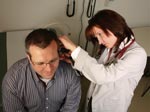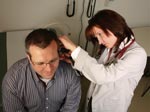
On Site, On Track
On-site health centers produce behavioral change in employees that locally-based health care services have been unable to provide.
- By Jerry Laws
- Apr 01, 2010

A CHS physician conducts a health teaching for an employee .
Today's on-site occupational health centers are the fruition of an evolution that began soon after the OSH Act was signed into law 40 years ago, when the chief task involved was treating work-related injuries. Medical surveillance was part of the package, then and now, but nonwork- related acute care and health management are now important components, said Stu Clark, executive vice president of Comprehensive Health Services Inc. (CHS), based in Reston, Va.
This shift occurred because workplaces were becoming safer. Companies found their health centers' staffers had time to do more, Clark said, and progressive companies responded by having their centers perform non-work-related acute care. Workers had to report to the centers on their own time, however.
The next move was providing prevention and chronic disease management programs. "The reason they began that was they recognized they should optimize the use of this clinical expertise on site to help affect the cost structure of their health plan and nonwork- related group health costs. And it worked," he said. It was a natural step for the workers to trust the on-site staffers to treat diabetes and hypertension and to really move those workers into a treatment pathway that helped to improve their overall health, thus boosting productivity.
CHS operates 93 on-site health centers today and expects to have 100 in operation by the end of 2010. In the old days, those centers utilized 90 clinical treatment guidelines and policies; they now utilize 230 that encompass acute care, prevention, and treatment of chronic illnesses such as diabetes and hypertension. They help employees with electronic health records and engage both employee and their family members with health risk assessment tools.
"Why is that important? Because it allows us to have a baseline on their health and, from there, we can help that employee or his/her family to get the treatment they need in the community or to access the resources that the employer is already offering," Clark said. "We're an optimizer."
For example, companies ordinarily cannot get employees and their families to enroll and to stay engaged in disease management (DM) programs. Typically, there is about a 14-18 percent uptake into DM programs offered by major employers. He said the CHS centers move the participation rate well up into the 40-50 percent range.
Getting Started, Showing Results
A vendor kickoffmeeting occurs when CHS is opening a new center. Th is meeting is held to determine where CHS will refer employees into the health plans and PBM vendors' care; the arrangement differs for each employer. "Not only are we moving the patient down that pathway of care, but we're also, with patient's permission, able to communicate that patient's health information to the provider. So when a patient is referred into the health coaching program, with proper HIPAA releases, we are able to provide baseline biometric data and consultation notes we've had with the employee so they can pick up the ball with a full understanding of that patient's health status."
Asked whether the results show bottom-line savings to employers, he answered, "The ROI is not driven by cheaper, faster acute care. And I think that's a misunderstanding, maybe perpetuated by some in our industry, that if you just put a doctor or nurse on site and you're able to quickly treat earaches and runny noses, that you're going to be able to save all this money. Well, that's not where the game is played.
"We absolutely have to offer acute care services, but here's an interesting concept: They come in for a runny nose or an earache, but we counsel them about their diabetes or their hypertension," Clark explained. "And so the low-hanging fruit here, the real money to be saved, is in dealing with diabetes and cardiovascular diseases. Our customers spend 25 percent of their health spend — one quarter of their health spend — on cardiovascular diseases and diabetes. And that's true nationally."
An on-site center that can better engage these workers and cause them to improve compliance according to recommended practices in diet, exercise, specialized care, etc. can have significant impact on the bottom line because it is attacking 25 percent of the problem, he said, adding, "Th at does not happen in the first year."
"Typically, it takes 12 to 18 months to recover capital expenses associated with building an on-site center. . . . Starting in late year two, you start to bend the curve relative to obesity, and cardiovascular diseases, and diabetes. The real driver of savings is year two and later specific to those disease classes."
With the patient's permission, a CHS center has his/her health risk assessment (HRA) data and other biometric information, such as blood sugar, weight, and compliance with standards — seeing an ophthalmologist annually, checking blood sugar as recommended, having the feet checked, and more. CHS is able to track the difference in health spending for employees with the diseases who are using the center and those who are not. "We're going to see lower hospitalization rates, fewer hospital bed days, lower specialist costs for our hypertensives versus those hypertensives in the other population," Clark said.
The financial gap grows the longer a center is in business. The employer's benefit design affects it by driving utilization, which drives costs; a customer who drives participation through reduced co-pays will see better results, he explained.
"Generally, we will be very disappointed if we don't see per capita a several thousand dollar decreased cost for diabetics and hypertensives who are using our health center versus those who aren't," Clark said. "Th at's a very material number because you're talking about thousands and thousands of people."
Catering to Small Businesses
Employers can drive higher usage just by creating access to the center. They can waive the co-pay for preventive or health consultation visits, waive or reduce co-pays for acute care visits, or even waive all co-pays. Some in the industry may claim to achieve 80 or 90 percent utilization, but Clark said he doubts such claims. "We don't believe it. We think that a target for the first year should be in the 30-35 percent range. We think that by year four or five, you should achieve 60-70 percent. But 60 is success, and 70 is unusually successful."
CHS and others in its industry really haven't tried to sell a model that allows multiple smaller employers in a given location to share a health center's costs and savings. "I think you're going to see that change. I think the industry is very motivated at the size of that market," said Clark. A few of the company's 93 centers function similarly, where a large employer allows some smaller ones to use it on an as-needed basis. It works well for both parties, he said.
"Our industry really needs to get focused on this," said Clark. "There's no doubt, the small employer has just been under assault from a health care cost increase standpoint. . . . We're hopeful that employers will be given incentives [by Congress] to encourage the use of on-site care. It makes eminent sense for an employer who undertakes this kind of cost to improve health to benefit, whether from some kind of tax credit or some other type of financial incentive. And we think there is a reasonable likelihood something like this will come out of Congress."
Clark has worked in the on-site health care industry since 1991, when he joined American Occupational Health Management, Inc., according to CHS. He served in operations and sales management roles and joined the senior management team aft er the company was sold to Meridian Occupational Healthcare Associates (Nashville, Tenn.) in 1996, leaving in 2005 as executive vice president in charge of four on-site operating divisions.
He said he never has seen the kind of demand the industry is seeing now. "Coupled with the fact that Americans are spending more and more hours at the work site, patients are more likely to engage providers and health care services when it's easy to access them, and it is easy when it's provided at the work site. And what we know empirically, because we're measuring it, is that employees who engage with an on-site provider are more likely to change their behavior. And that's where the game is. If you can get them to quit smoking, or to start eating healthy, or to exercise, or to get more sleep, then health care costs come down."
The data prove use of on-site health centers raises engagement rates and lowers health care costs. The linchpin in all of it is that the centers change the employee patients' behavior. By comparison, "the community health resources, as hard as they try and as smart as they are, have been unable to change behaviors in this country," Clark said.
About the Author
Jerry Laws is Editor of Occupational Health & Safety magazine, which is owned by 1105 Media Inc.